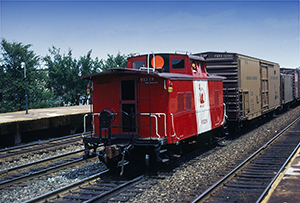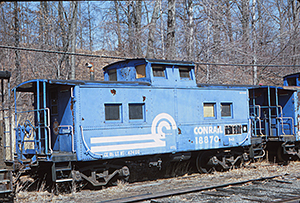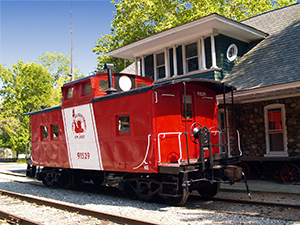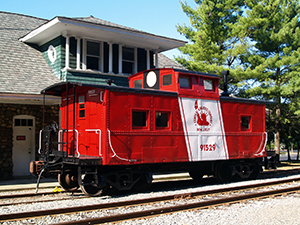
Caboose No. 91529 was one of 50 steel cabooses built by the Central Railroad of New Jersey (CNJ) at its Elizabethport, NJ car shop during the first half of 1942. It is based on a Reading Railroad design (first built in the mid-1930’s) that became popular among the railroads in America’s anthracite coal region. With minor variations, similar cabooses could be found on the Reading, Lehigh Valley and Western Maryland railroads.

These cabooses were numbered 91500 – 91549 and designated CNJ class ‘NE’. They were constructed under authorization of Federal District Court – CNJ Order # 87 of 1941 at a cost of $3,345.62 each. The court order was required because the CNJ was in Section 77 Bankruptcy from 1939 until 1949. No. 91529 was completed and placed in service in May 1942 with a gross weight of 43,400 lbs. At the time of construction each CNJ caboose had four windows on both sides of the car, but this was changed at a later date when the window behind the coal stove was plated over.

Since their construction, the CNJ’s ‘NE’ – class steel cabooses remained basically the same, with a few minor exceptions. During 1944 and 1945 the original ‘New Jersey Central’ “ball” logo on the sides of these cabooses was replaced with the new ‘Jersey Central Lines’ Statue of Liberty herald. As an added safety precaution the CNJ painted all their cabooses with a large red fluorescent dot on a black background between the windows on the ends of the cupola. With the exception of the exterior paint scheme the only other modification made by the CNJ to these cabooses was the installation of new sanitary facilities. The 91529 was one of the first to get this improvement, which was installed in June 1956.



Beginning in April 1965 the CNJ modified their logo by replacing the words ‘Jersey Central Lines’ with ‘Central Railroad Company of New Jersey’ around the Statue of Liberty image. Shortly thereafter the 91529 received a new coat of red paint and sported the new CNJ herald in white.


Starting around 1972, the primary CNJ caboose color was changed to a bright fire-engine red, and a diagonal white stripe was added with the herald painted on it in red to match the new diesel locomotive paint scheme. This design was dubbed the ‘Coast Guard Scheme’. In 1975, this was later simplified to eliminate the bold white center stripe and re-stencil the herald in its original white color.


In 1969 No. 91529 was assigned to the CNJ’s Southern Division, operating on trains JS-1 and JS-2, which ran between Bridgeton and Jersey City, NJ. The scheduled running time of these two trains was 12 hours in each direction.
On April 1, 1976 No. 91529 was acquired by Conrail (CR). Seven months later, on November 1, 1976 No. 91529 was sent to CR’s Reading, PA car shops where it was painted into the CR blue and white paint scheme and given CR number 18870, and designated CR caboose class ‘N4B’. In addition to the painting, the coal-burning caboose stove was removed and replaced with an oil-fired heating unit and new sanitary facilities were installed. No. 18870 / 91529 remained in service on the Conrail roster until 1985. In the Fall of 1985 CR offered 18870 / 91529 and other equipment for sale on a bid list.




The caboose was purchased by a successful bidder and the car was moved to Whippany, NJ arriving there on Saint Patrick’s Day, March 17, 1986. Shortly thereafter, the car was resold to three individuals who restored the car’s exterior in the CNJ’s 1945 paint scheme. The interior, however, was never completed.



In December 2009, CNJ Caboose No. 91529 was acquired by the Whippany Railway Museum. Museum members began working on the caboose in the Spring of 2010, and by mid-Summer, the interior had been restored. Once warmer weather returned in 2011, the restoration crews turned their attention to the exterior work, and by early July 2011, the caboose was fully restored to the CNJ’s striking red and white ‘Coast Guard’ scheme of 1972.



